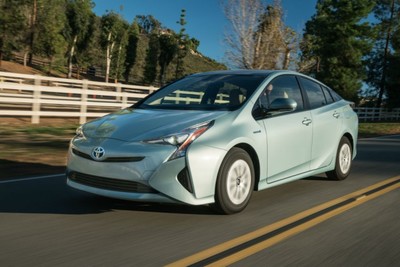2016 Toyota Prius Three Review
2016 TOYOTA PRIUS THREE
Review by Steve Purdy
The Auto Channel
Michigan Bureau
Over the years Toyota’s lineup of full-hybrid Prius cars broadened significantly from the original timid little sedan of the late 1990s as styling evolved adding more character. Then the smaller Prius C emerged along with a larger Prius V. In 2009 we saw a more intensely electric plug-in version as well. The plug-in Prius Prime just got its first significant redesign and we reviewed it HERE
Our test car this week is known as Prius Three, which just means the regular size hybrid Prius in its middle trim level. The lesser Prius Two and Two Eco slots below, and the higher end Prius Four and Four Touring slots above in price and content. Prius Three pricing begins at $26,250. Our tester has the Technology Package and a few other options bringing the bottom line sticker price up to $$29,842.
The amazing powertrain in the regular Prius lineup consists of a 1.8-liter, Atkinson cycle engine making just 95 horsepower and 105 pound-feet of torque on its own but is augmented with an electric motor/generator that brings it up to a net 121 horsepower. A lithium-ion battery pack stores electricity to be used when you need it and regenerative braking helps keep the batteries charged. Sophisticated electronic controls balance the power systems most efficiently. The EPA says we can expect around 54 mpg in the city, and 50 on the highway with this small car that weighs just over 3,000 pounds. Our experience with it this week included a trip to Chicago, 3.5 hours each way, and we topped 55 mpg combined. Not bad, eh?
The Prius lineup experienced a significant redesign little more than a year ago, including a new global platform that adds significant rigidity and better suspension. Exterior styling takes a big leap forward adding substantial drama while maintaining the wedge shape and overall profile that has made the Prius easy to recognize. A more expressive front fascia, deep character lines all around, narrower A- and B-pillars, a sleek floating rear roofline and truly brash LED taillights with a zigzag shape, set this car off without obscuring its brand identity. Active grille shutters and a coefficient of drag of just 0.24 add to its efficiency.
The new Prius is a couple inches longer and just about a half inch wider with better cargo capacity. The batteries are under the rear seat allowing a more efficient use of the available space resulting in an impressive 24.6 cubic-feet with rear seatbacks in place. A spare tire is not included. Regenerative braking continues to contribute to efficiency and new aluminum brake calipers contribute to the weight loss.
The dash and other interior details get a full redesign as well with a wrap-around, horizontal theme replacing the former car’s attractive but more diminutive and curvaceous style. It gets a new, double 4.2-inch display with full color, better seats, some classy stitching, and better materials to bring its look upscale. An optional heads-up display keeps some crucial information in front of the driver as the main instrument cluster remains in the center as in the outgoing car. Materials are both better quality and more stylish with some two-tone color schemes and more contrasting hues.
Available on most Prius models is a new “Safety Sense” system with automatic pre-collision braking and other driver assistance systems. We tested the systems at the new Prius’ relaunch last year where they set up a couple of demonstrations of how the system will intervene bringing the car to a complete stop if the driver fails to take control in time. It was a bit disconcerting at first as instinct told me we were going to hit the barrier. But when I was finally able to let the car control the situation it came to a sharp, hard stop just inches from the simulated van and pedestrian. The system costs about $600 extra, but for some folks might be worth the cost. Also standard on all models is a rear-view camera.
All models come with alloy wheels, but that’s not what you think. They are not styled alloys. Rather they appear much like a stamped steel wheel and all have styled plastic wheel covers designed for aerodynamics. Low rolling resistance tires are provided. While Toyota claims they are optimized for grip.
I found the overall handling quite good with decent steering feedback and surprisingly flat cornering - due, probably to a combination of the new rear suspension and the much more rigid chassis. It was also remarkably quiet inside as they’ve added much more sound deadening material under and around the cabin.
Toyota’s new car warranty will cover the car for 3 years or 36,000 miles and the powertrain for 5 years or 60,000 miles. Hybrid components are covered for 8 years or 100,000 mile.
Prius’ leadership in the field comes from both longevity and competence, now enhanced by spirited design. Toyota’s Synergy drive hybrid system pioneered the use of gas and electric together and had been revised over the years to keep getting better. Many potential customers worried about having to replace an expensive battery pack at some point but these packs have proven dependable, essentially lasting the life of the car.
©Steve Purdy, Shunpiker Productions, All Rights Reserved
The Most In-Depth Toyota Vehicle Shopper's Research - Anywhere!
MORE TOYOTA INFORMATION
- Toyota Buyers Guide | Specs, Prices, Expert Reviews and Comparisons 2017-1997
- Find Your Perfect New Vehicle Match
- Toyota Reviews From The Auto Channel (1993-Present)
- The Auto Channel's Toyota Brand Archives; News, Press Releases, Reviews, Specifications, Prices, Video, Images (64,626 Annotations)



